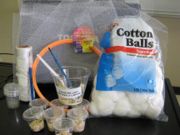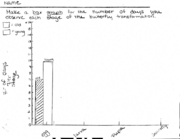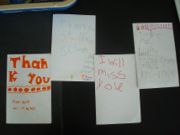Crawling to Flying: The Life Cycle of a Butterfly
| Instant wiki maker | Making handouts | Editing tips |
Biology In Elementary Schools is a Saint Michael's College student project from a course that ran between 2007 and 2010 and fully described in this book chapter. The student-created resources have been preserved here for posterity. Link under 'toolbox' for printer-friendly versions of the exercises. Click on handouts to print full resolution versions. Please see Wikieducator's disclaimer, our safety statement, and the Creative Commons licensing in English and in legalese.
Student worthiness
This experiment has been tested with second grade students and works wonderfully.
Primary biological content area covered
This lesson plan introduces and explains the life cycle of a butterfly. A “butterfly gazebo” is made to house the caterpillars and then the butterflies. With this “butterfly gazebo” the children will be able to observe the caterpillar grow, take the form of a chrysalis and then into a butterfly. During the twenty minute lesson plan, the children will learn this life cycle of a butterfly through the book, The Very Hungry Caterpillar. They will then demonstrate what they learned by using dramatic play. They will use towels, sheets and blankets to show the three stages of the life cycle. Then over the course of the next week or so, the children will be able to watch the life cycle come to life through their “butterfly gazebos”.
Materials
Materials for Butterfly Gazebo
- 10 yards of bridal netting
- ribbon/string
- cardboard
- embroidery hoops
- solo ketchup containers
- paint brushes
- sewing needle
- 10 painted lady caterpillars & food
- twigs
- leaves
- cotton balls
- water
Materials for Butterfly Activity
- life cycle handout
- The Very Hungry Caterpillar
- crayons
Handouts
Two worksheets will be handed out, one that has the students identify each stage and label the stages. The other worksheet is a graph that students will record how many days the caterpillar is in each stage up until it turns into a butterfly and they set it free.
Description of activity
Students will learn about the life cycle of a butterfly. A butterfly starts out as a small caterpillar and continues to eat and grow over the course of a couple weeks. Then the caterpillar wraps itself in a chrysalis; this is known as the resting or transformation stage. After 2-3 weeks a beautiful butterfly emerges. The students will be able to bring caterpillar gazebos back to their classrooms so they can observe and chart the cycle themselves.
Lesson plan
- First, we will introduce the topic to the students. We will ask them what they know about the life cycle of a butterfly.
- Next, we will read The Very Hungry Caterpillar which describes the life cycle of a butterfly.
- Next, we will give the students a bar graph (Figure 3) and explain how they can track the stages of the caterpillars we are giving them. They will chart how many days they remain caterpillars, how many days they are in their chrysalis stage, and then what day they become butterflies.
- To assess their learning, we will give them a sheet with an illustration of each cycle of the butterfly's life (Figure 2). At the top of the sheet we will provide a word bank: larva, pupa, egg, and butterfly. The students will have to write the correct word from the word bank above the matching illustration. When they are finished, they can color the pictures!
- Butterfly Gallery
Potential pitfalls
From doing this lesson a possible pitfall would be keeping attention of students who have heard and know the story of the very hungry caterpillar. A way to avoid such a problem is to try and find a less common children's book on caterpillars and the transformation to becoming a butterfly. Another problem we encountered was that the students were going to be on vacation the week following our visit. This means that they would not be able to observe the caterpillars change for an entire week. Therefore, the students would not have a full graph or even accurate graph of the transformations from stage to stage.
Math connections
- In this activity students will learn and practice the skill of using a bar graph to chart the number of days the caterpillar spends in each stage of its life cycle.
Literature connections
Carl, Eric. The Very Hungry Caterpillar. Philomel, 1994.
This book will help children to understand why the caterpillar needs to eat a large amount of food before entering into its cocoon and changing into a butterfly. The teacher might read the book to students and then have a large group discussion about the life cycle of a butterfly. This would be read in conjunction with observing the actual transformation of a caterpillar into a butterfly.
Heiligman, Deborah. From Caterpillar to Butterfly. Herper Collins, 1996.
This book may also be read in conjunction with the observation of an actual caterpillar changing into a butterfly. It provides scientific facts about each stage that the caterpillar goes through during its transformation.
Connections to educational standards
Vermont Grade Level Expectations
S1-2:31 Students demonstrate their understanding of Reproduction by …
- Drawing and labeling the stages of development in the life of a familiar plant or animal.
Science Concepts:
- a. All organisms undergo stages of development that include being born, developing into adulthood, reproducing and dying.
- b. Most organisms come from male and female parents.
Next steps
In order to help the students further understand the transformation that a caterpillar goes through in order to become a butterfly, each student can act out the different stages using towels and blankets. They can begin by crawling around as a caterpillar representing the larva stage, then using the blankets or towels, wrap themselves up completely to represent the chrysalis stage, and then finally, using the towels or blankets as wings, become a beautiful butterfly. This will not only help the students to comprehend the life cycle of a butterfly in a more thorough level, but it will also allow for them to express their knowledge through the use of drama in the classroom.
Reflections
After our visit to the school and working with the students we found that the book we read was fairly common and most of them knew the story. Further, we found that the students would miss out on a week of observing the caterpillars due to April break. The students were very well informed prior to our visit and they seemed to know very much about the transformation from caterpillar to butterfly. This helped us to move quickly within our 20 minute time constraint. The only thing that would strengthen this lesson is a continuation of it throughout the transformations and keep the graph updated.












